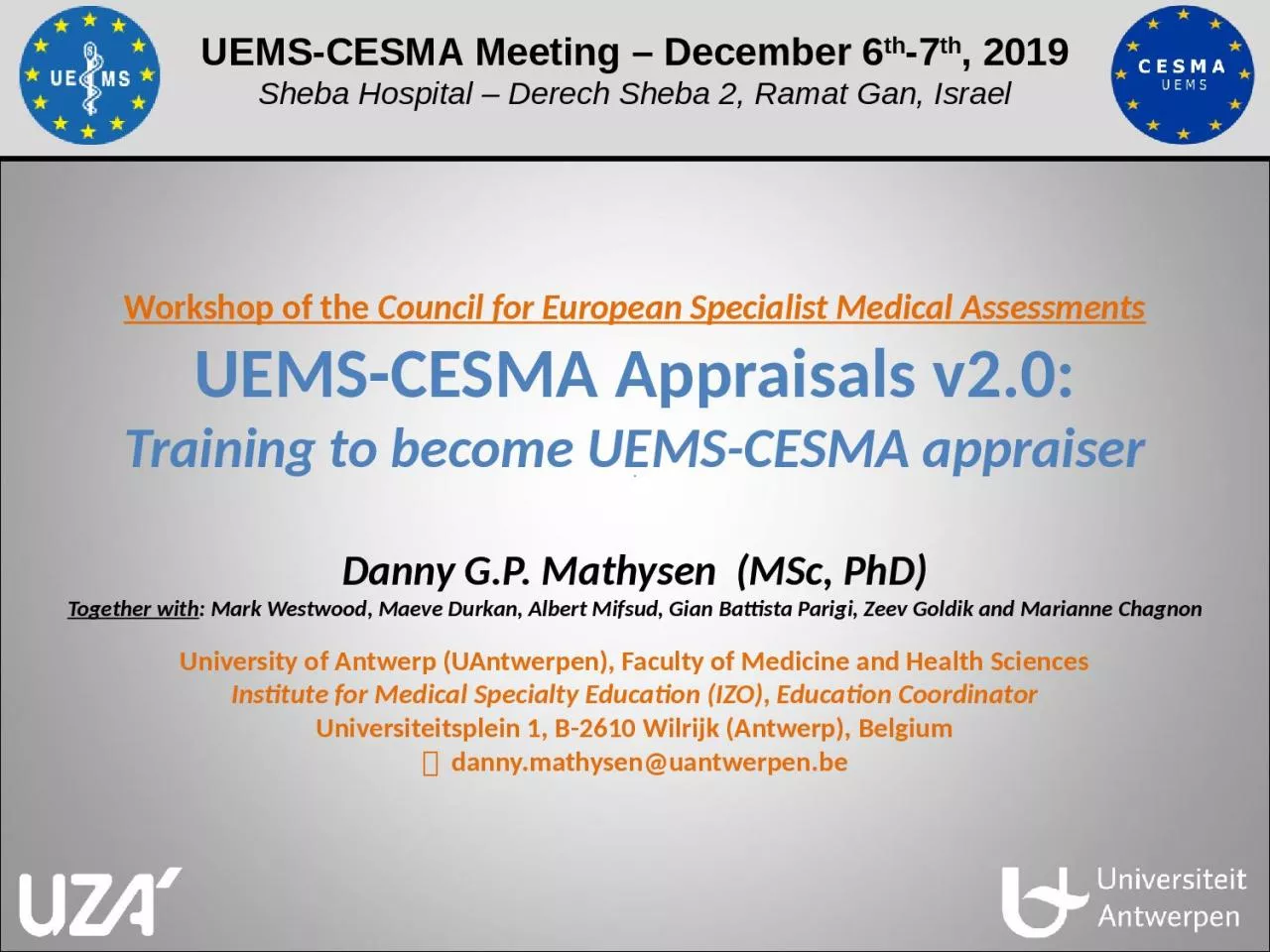

UEMSCESMA Appraisals v20 Training to become UEMSCESMA appraiser Danny GP Mathysen MSc PhD Together with Mark Westwood Maeve Durkan Albert Mifsud Gian Battista Parigi Zeev Goldik ID: 929970
Download Presentation The PPT/PDF document "Workshop of the Council for European Sp..." is the property of its rightful owner. Permission is granted to download and print the materials on this web site for personal, non-commercial use only, and to display it on your personal computer provided you do not modify the materials and that you retain all copyright notices contained in the materials. By downloading content from our website, you accept the terms of this agreement.
Slide1
Workshop of the Council for European Specialist Medical AssessmentsUEMS-CESMA Appraisals v2.0:Training to become UEMS-CESMA appraiser
Danny G.P. Mathysen (MSc, PhD)
Together with
: Mark Westwood, Maeve Durkan, Albert Mifsud, Gian Battista Parigi, Zeev Goldik
and
Marianne Chagnon
University of Antwerp (UAntwerpen), Faculty of Medicine and Health Sciences
Institute for Medical Specialty Education (IZO), Education Coordinator
Universiteitsplein 1, B-2610 Wilrijk (Antwerp), Belgium
danny.mathysen@uantwerpen.be
Slide2Gathering of informationPlanning of the audit visitOpening interviewAuditFinal discussionAudit reportPhases of an external quality audit
UEMS-CESMA Appraisal application
Planning of the Appraisal visit
Opening interview on-site
UEMS-CESMA Appraisal visitPreliminary report by the AppraisersUEMS-CESMA Appraisal report
Phases of an external quality audit according to official training methods of auditors of the International Organization for Standardization (ISO)
Slide3Preparation of the examinationQuestion writingQuestion bankingQuestion selection and blueprintDelivery of the examinationInstructions to candidates prior and during the examinationActual delivery methodProcessing of the examinationScore calculation methods and pass mark setting methods
Appraisal of examination process
Slide4Appraisal of examination process
Task of UEMS-CESMA Observers: evaluation of the examination venue …
Slide5Appraisal of examination process
Task of UEMS-CESMA Observers: evaluation of the security measurements …
Slide6Appraisal of examination process
Task of UEMS-CESMA Observers: determine
whether the examination is objective for all candidates
Slide7Appraisal of examination process
Task of UEMS-CESMA Observers: rule out whether the examination format and examination questions are appropriately organised …
Slide8Appraisal of examination process
Task of UEMS-CESMA Observers: veryfing methods applied
for score calculation and pass mark setting …
Slide9Conduct of the UEMS-CESMA Appraisal visitFollow the Audit plan which has been prepared and explained during the Opening interview on-siteAllow for extra audit items which are triggered by observations made during the appraisal visitUEMS-CESMA Appraisal visit: What needs to be evaluated? ➼ 5 M methodM
1
=
Manpower
involved in the organisation of the European postgraduate medical assessmentM2 = Machinery used for the organisation of the European postgraduate medical assessment M3 = Materials used in the organisation of the European postgraduate medical assessmentM4 = Methods used for the organisation of the European postgraduate medical assessmentM5 = Means for delivery of the European postgraduate medical assessment (examination venue)IV. UEMS-CESMA Appraisal visit
Slide10UEMS-CESMA Appraisal visit: How to evaluate each M? ➼ 3 Q/C methodQ1 = Quality aspectsQ2 = Quantity aspects
C
3
=
Cost-benefit analysis (not only in financial but also in non-financial context)UEMS-CESMA Appraisal visit: How to judge each Q/C? ➼ 6 W methodW1 = Who?W2 = What? W3 = Where?W4 = Which (how)?W5 = When?W6 = Why?IV. UEMS-CESMA Appraisal visit
Slide11Does the UEMS-CESMA Appraisal team aims to observe the perfect examination where nothing goes wrong? NoDoes the UEMS-CESMA Appraisal team aism to observe an examination with a solid quality assurance and management system in place? YesHow can the requiring UEMS body document such a quality assurance and management system? By showing the PDCA cycle (Deming circle) which is usedIV. UEMS-CESMA Appraisal visit
Slide12Efficient time usage for members of the Appraisal team:Divide the tasks equally among the members of the Appraisal teamBuild in intermediate moments of discussion between the members of the Appraisal teamRedefine the Audit plan on-site based on direct observationsShare key elements in the observations (positive and negative)
Do
NOT
start writing the Appraisal report on-site!
IV. UEMS-CESMA Appraisal visit
Slide13Structure of the preliminary report on-siteStress once again the confidentiality which was respected by the UEMS-CESMA Appraisal teamDescribe the top 5 of positive observations that were made by the UEMS-CESMA Appraisal teamExplain the (modified) audit plan which has been actually used based on direct observationsAnnounce already the major suggestions that will be formulated in the Appraisal reportFinal check whether the members of the Appraisal team have fully understood
all aspects
Required presence of:
at least one member of the UEMS-CESMA Appraisal team, chair of examination committee,
at least one representative of the requiring UEMS bodyWhen and where to be organised?Immediately after the conclusion of the examination (e.g. evening)On-site (i.e. at the examination venue)V. Preliminary report
Slide14Faleminderit shumë (Albanian) Shterakravetsun (Armenian) Eskerrik asko (Basque) Mnogo blagodarya (Bulgarian) Dzãkujã (Cassubian) Moltes gràcies (Catalan) Merastawhy
(Cornish)
À ringraziavvi
(Corsican) Hvala lijepa (Croatian) Dĕkuji (Czech) Mange tak (Danish) Dank u wel (Dutch) Thank you (English) Ic sæcge eow Þancas (English, old) Dankon al vi (Esperanto) Aitäh (Estonian) Paljon kiitoksia (Finnish) Merci beaucoup (French) Tanke wol (Frisian) Graciis (Friulian) Grazas (Galician) Mèrczi (Gallo) Merci (Gascon) Besten dank (German) Merci villmahl (German: Zurich Switzerland)
Ευχαριστώ (Greek) Toda raba (Hebrew) Nagyon köszönöm
(Hungarian)
Takk fyrir
(Icelandic)
Gratias
(Interlingua)
Qujanaq
(Inuttut)
Go raibh mile maith agaibh
(Irish Gaelic)
Gratias tibi ago
(Latin)
Liels paldies
(Latvian)
Mouchou gratzia
(Lingua Franca)
Labai achiu
(Lithuanian)
Merci
(Luxembourgish)
Grazzi hafna
(Maltese)
Gura mie mooar ayd
(Manx)
Merçì
(Monegasque)
Gràzzie
(Napulitano) Dziękuję (Polish) Obrigado (Portuguese) Mercé plan (Provencal) Nais tuke (Romani: gypsy) Oven saste (Romani) Mulţumesc (Romanian) Grazia fitgun (Romantsch) Спасибо (Russian) Giitus eanat (Saami Lappish) Moran taing (Scottish Gaelic) Grazzii (Sicilian) Dakujem vám (Slovak) Hvala lepa (Slovenian) Dz’akujo so (Sorbian) Muchas gracias (Spanish) Dankeschee (Swabian) Tackar så mycket (Swedish) Çok tesekkür ederim (Turkish) Moltes gracies (Valencian) Merci (Walloon) Diolch yn fawr iawn (Welsh) A dank aych (Yiddish)
Thank you …